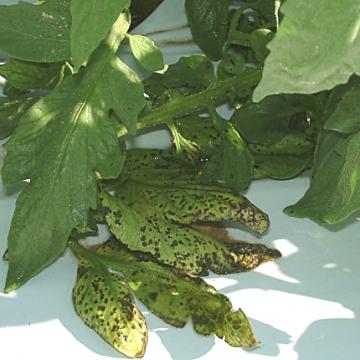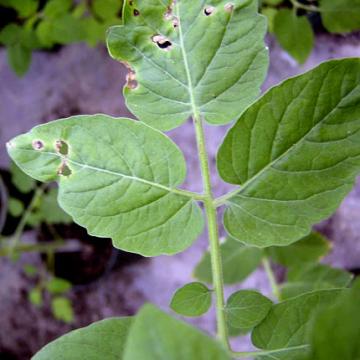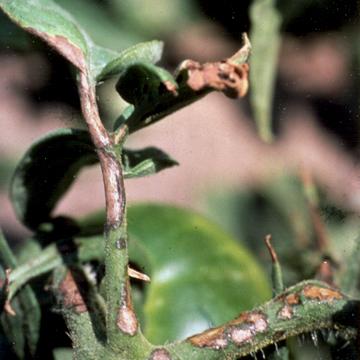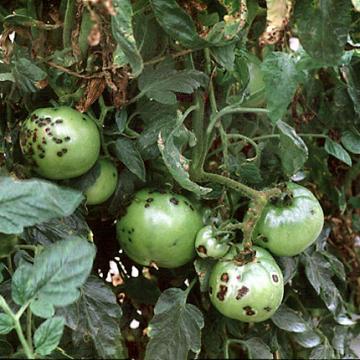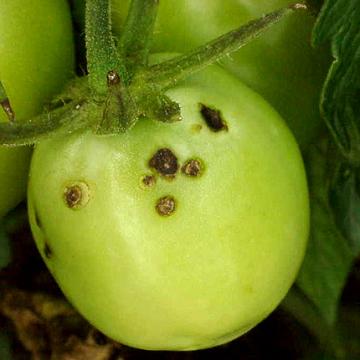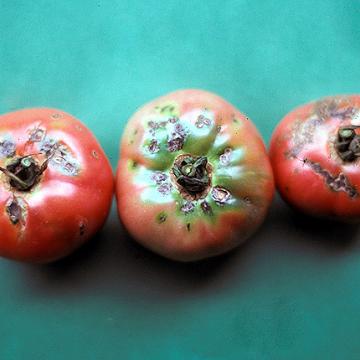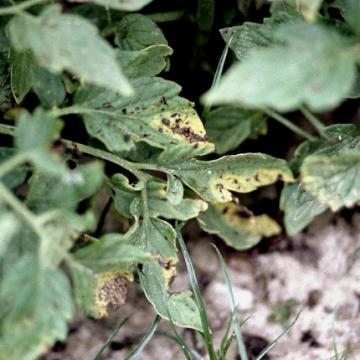DISEASE: Bacterial spot
HOST: Tomato
Infected lower leaves with multiple necrotic spots. Bacterial spot xanthomonads are Xanthomonas euvesicatoria, X. vesicatoria, X. perforans, and X. gardneri. X. perforans is not known to infect fruit.
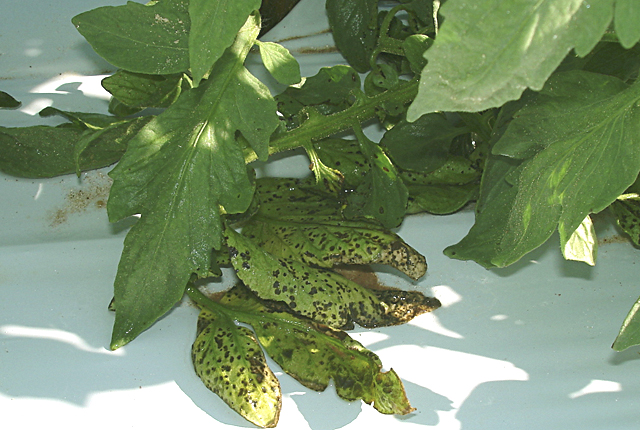
Bacterial spot | Tomato
DISEASE: Bacterial spot
HOST: Tomato (Lycopersicon esculentum)
PATHOGEN: Xanthomonas bacterial spot pathogens
PATHOGEN SYNONYM: Xanthomonas axonopodis pv. vesicatoria
SOURCE: J. Jones
DISEASE: Bacterial spot
HOST: Tomato
Necrotic leaf lesions and shot-hole appearance. The bacterial spot xanthomonads are Xanthomonas euvesicatoria, X. vesicatoria, X. perforans, and X. gardneri. X. perforans is not known to infect fruit.

Bacterial spot | Tomato
DISEASE: Bacterial spot
HOST: Tomato (Lycopersicon esculentum)
PATHOGEN: Xanthomonas bacterial spot pathogens
PATHOGEN SYNONYM: Xanthomonas axonopodis pv. vesicatoria
SOURCE: J. Jones
DISEASE: Bacterial spot
HOST: Tomato
Necrotic lesions on stems and petioles. The bacterial spot xanthomonads are Xanthomonas euvesicatoria, X. vesicatoria, X. perforans, and X. gardneri. X. perforans is not known to infect fruit.
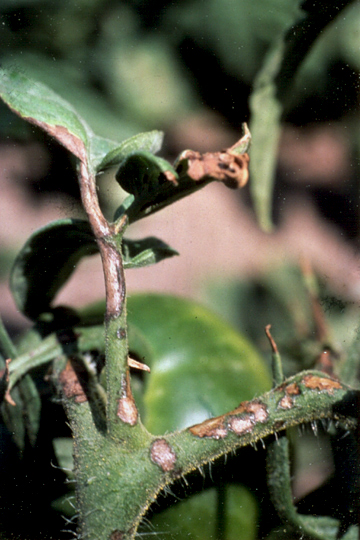
Bacterial spot | Tomato
DISEASE: Bacterial spot
HOST: Tomato (Lycopersicon esculentum)
PATHOGEN: Xanthomonas bacterial spot pathogens
PATHOGEN SYNONYM: Xanthomonas axonopodis pv. vesicatoria
SOURCE: B. S. Kim
DISEASE: Bacterial spot
HOST: Tomato
Severely infected fruit and leaves. The bacterial spot xanthomonads are Xanthomonas euvesicatoria, X. vesicatoria, X. perforans, and X. gardneri. X. perforans is not known to infect fruit.
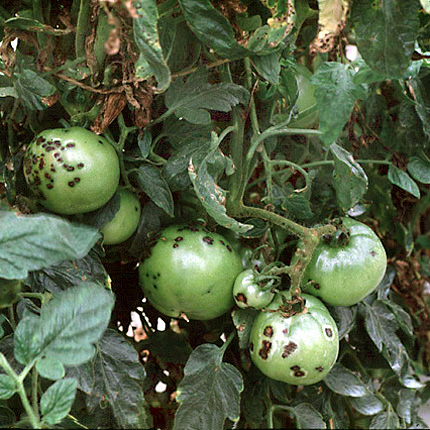
Bacterial spot | Tomato
DISEASE: Bacterial spot
HOST: Tomato (Lycopersicon esculentum)
PATHOGEN: Xanthomonas bacterial spot pathogens
PATHOGEN SYNONYM: Xanthomonas axonopodis pv. vesicatoria
SOURCE: J. Jones
DISEASE: Bacterial spot
HOST: Tomato
Green fruit with dark brown lesions. The bacterial spot xanthomonads are Xanthomonas euvesicatoria, X. vesicatoria, X. perforans, and X. gardneri. X. perforans is not known to infect fruit.
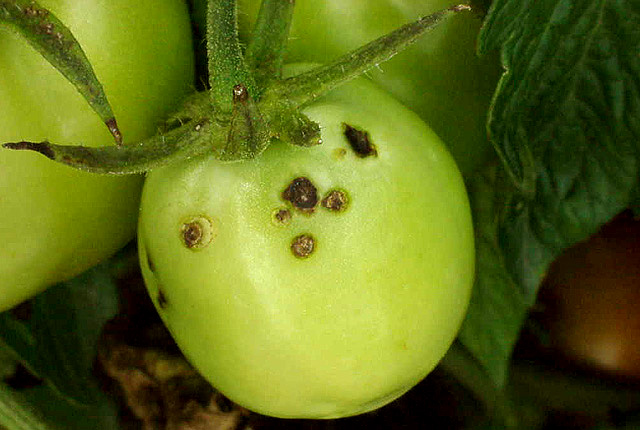
Bacterial spot | Tomato
DISEASE: Bacterial spot
HOST: Tomato (Lycopersicon esculentum)
PATHOGEN: Xanthomonas bacterial spot pathogens
PATHOGEN SYNONYM: Xanthomonas axonopodis pv. vesicatoria
SOURCE: S. Miller
DISEASE: Bacterial spot
HOST: Tomato
Ripe fruit with dark brown spots. The bacterial spot xanthomonads are Xanthomonas euvesicatoria, X. vesicatoria, X. perforans, and X. gardneri. X. perforans is not known to infect fruit.
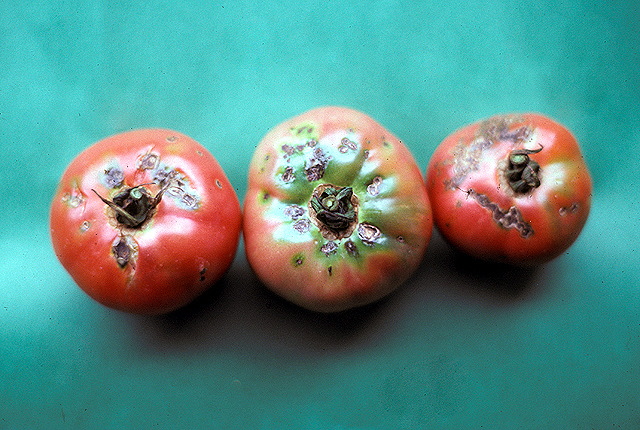
Bacterial spot | Tomato
DISEASE: Bacterial spot
HOST: Tomato (Lycopersicon esculentum)
PATHOGEN: Xanthomonas bacterial spot pathogens
PATHOGEN SYNONYM: Xanthomonas axonopodis pv. vesicatoria
SOURCE: M. Goto
DISEASE: Syringae leaf spot
HOST: Tomato
Leaves with brown necrotic lesions and chlorotic margins. Symptoms vary greatly among cultivars. Some have black or brown lesions with bright yellow, chlorotic areas and others do not have yellowing.

Syringae leaf spot | Tomato
DISEASE: Syringae leaf spot
HOST: Tomato (Lycopersicon esculentum)
PATHOGEN: Pseudomonas syringae pv. syringae
SOURCE: R. Gitaitis


